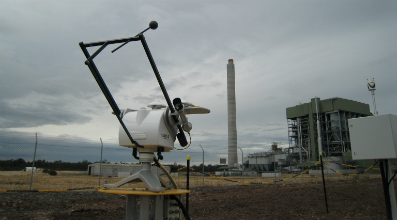Kogan Creek Solar Boost Project
Published: Tuesday, August 14, 2012
Australian electricity generator CS Energy has installed a Kipp & Zonen sun tracker and instruments at their Kogan Creek Power Station, to develop a detailed understanding of the local solar resource.
Kogan Creek Power Station in Queensland is a 750 MW supercritical dry-cooled coal-fired power station, and is Australia’s largest single unit. CS Energy is developing ‘Solar Boost’, a 44 MW solar thermal augmentation of the existing coal-fired power station, which would be the largest coal-solar hybrid power station in the world. The project will use Areva’s Compact Linear Fresnel Reflector (CLFR) technology to turn feedwater into superheated steam, supplementing the steam generation from the coal-fired boiler. This solar addition will enable the Kogan Creek Power Station to produce more electricity with the same amount of coal and reduce the station’s greenhouse intensity.
CS Energy is also developing two large (150-250 MW) standalone solar thermal power stations in the Kogan Creek area, having been shortlisted within two consortia for funding under the Federal Government’s Solar Flagship Program.
Dr. Ben McGarry, renewable energy engineer at CS Energy, said the design and deployment of high quality monitoring hardware for the solar resource assessment was pivotal to establishing the business cases for all three solar thermal projects. The solar resource assessment campaign is contributing to the design and sizing of the solar thermal technology as well as the revenue side of the business model. Dr McGarry said “Raw renewable energy may be free, but the technology required to convert sunlight to useful electricity requires a relatively large capital expenditure upfront. The electricity and revenue produced from that investment depends heavily on the local solar resource, so we needed to use the best available instruments to minimise uncertainty. Where there are hundreds of millions of potential investment dollars riding on the data, you want to be able to sleep at night.”
 The system comprises a Kipp & Zonen SOLYS 2 sun tracker with CHP 1 Pyrheliometer, 2 x CMP 21 Pyranometers and a third party legacy pyranometer carried over from a previous installation. Dr McGarry said the Kipp & Zonen equipment was an easy choice - “When I started researching the instruments that were out there, it quickly became clear that we couldn’t go past Kipp & Zonen in terms of accuracy and reliability. As a mechanical engineer, I was impressed by the mechanical design of the tracker and instruments, and I’m comfortable that it will withstand the tough site conditions.”
The system comprises a Kipp & Zonen SOLYS 2 sun tracker with CHP 1 Pyrheliometer, 2 x CMP 21 Pyranometers and a third party legacy pyranometer carried over from a previous installation. Dr McGarry said the Kipp & Zonen equipment was an easy choice - “When I started researching the instruments that were out there, it quickly became clear that we couldn’t go past Kipp & Zonen in terms of accuracy and reliability. As a mechanical engineer, I was impressed by the mechanical design of the tracker and instruments, and I’m comfortable that it will withstand the tough site conditions.”